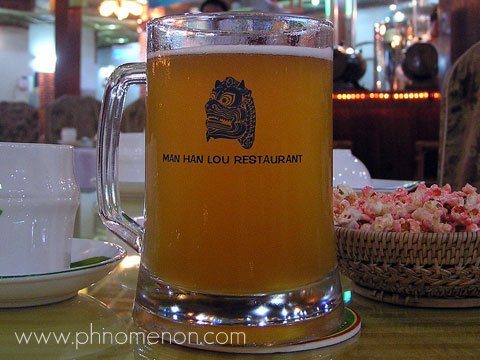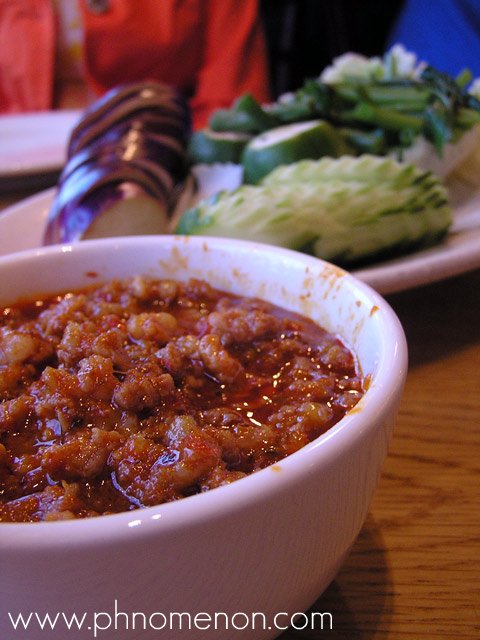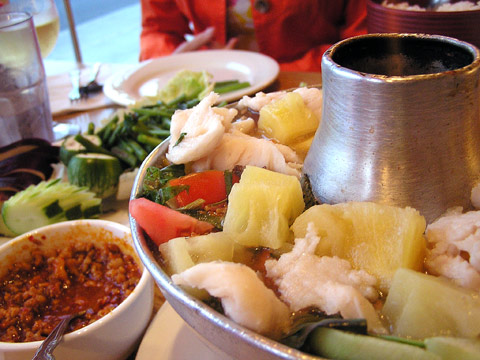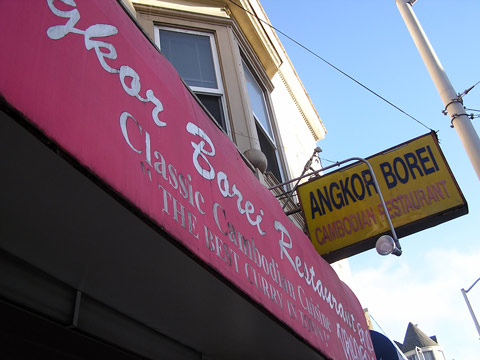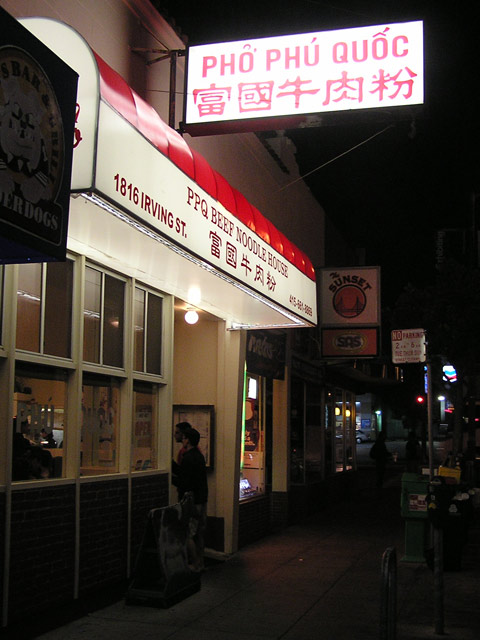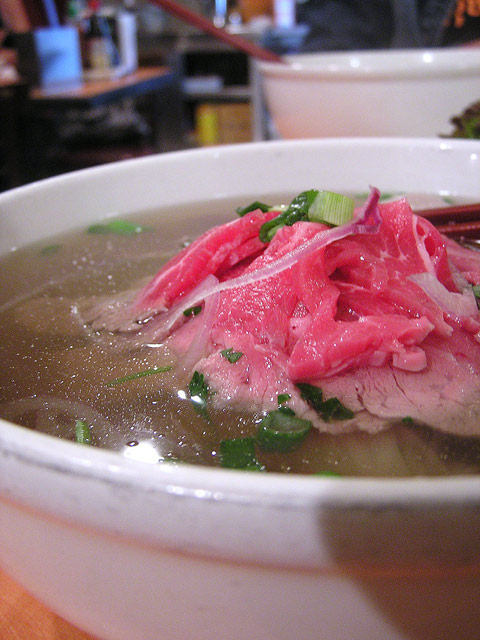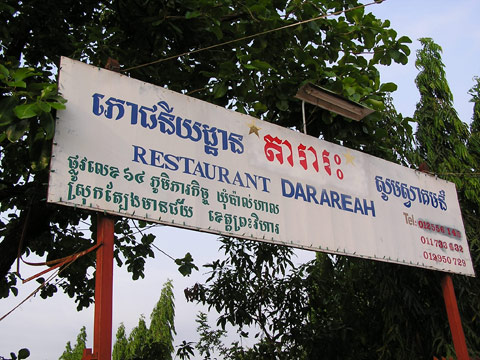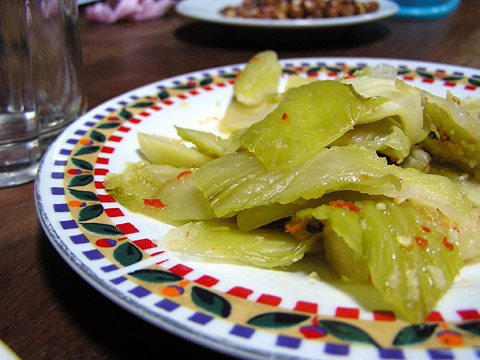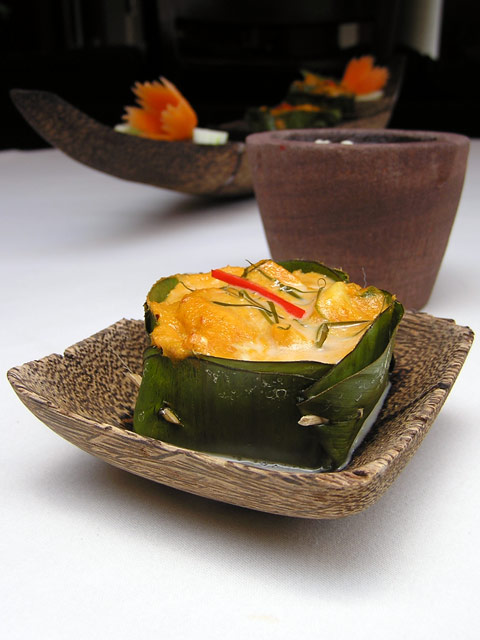Much like this blog, Phnom Penh dive bar Alley Cat recently celebrated their fourth anniversary. That’s 70 years old in Cambodian bar years, managing to outlive much healthier bars, subsisting on a diet of Mexican and gigantic hamburgers.
Category: Restaurants
Food away from home
Life is sweet

Nhoam svay trey chhaoe (Green mango salad with smoked fish)
I spent a whole lot of time in Phnom Penh reliving my old life. I had plans to cover a few new restaurants but the holiday temptation to slide back into the old ways was too powerful.
Part of that life is Sweet Cafe. Sweet is the most dependable Khmer restaurant in town. Of all the Cambodian restaurants in Phnom Penh, it was here that I dined with most frequency. Order the most traditionally Khmer-looking foods on the menu and you’ll never walk away disappointed. Order something not from the pantheon of Cambodian foods, vegetarian for instance, and chances are you’ll be served up a loosely inedible dish in a glutinous sauce. This is a restaurant designed for middle class Cambodia and not for the unpredictable caprices of Westerners who occasionally drop in.

Trokun de luxe – kangkong stir fried with chili, whole garlic cloves and shredded lotus stem.
The one thing that has changed at Sweet is the menu; now an approachable photographic bible of meals. If you were keen on methodically eating a swathe through the cuisine, this would be a great place to start. There are not less that 200 dishes presented in full pictorial glory. Order a sour soup, a salad and a fish and you’ll never eat poorly.

Samlor machou yuon (”Vietnamese”-style sour soup)
Location: Sweet Cafe, 21B Street 294
Phnom Penh Microbrew
I leave Phnom Penh for a month and a half to discover that firstly, there is a microbrewery that has been in operation for four months and secondly, that it is located not more than 200 metres from my house. There is some injustice that I leave Cambodia in a few days time.
Man Han Lou Restaurant, a gargantuan Chinese-Khmer eatery south of the Monivong-Mao Tse Toung intersection, has extended their lower level to include a mash tun and five shiny stainless steel fermentors for brewing four different beers: a pale ale (Gold); an amber ale (Red); a porter-cum-stout (Black); and a Green beer of unknown class. Their setup looks clean and temperature-controlled behind glass at the back of the bar. At night the restaurant is hard to miss, being lit in blue fairy lights like a low-rent Smurf casino.
The pale ale (Gold) is a cloudy change from the crystal clear local brews. It’s light on the hops and malt but unlike every other Cambodian beer, you can actually discern that hops and malt are used in its manufacture. The Black is a neutral stout at the bottom end of the alcohol range. It’s no Extra Klang. For a stout, it makes for easy drinking and a great beer to convert the non-stout drinking masses to the concept that stout can make for a top tropical heat tipple. Both the amber (Red) and the Green beer are undistiguished, which does beg the question of what colorant is used in the Green and for what purpose?
Price: Man Han Lou Gold Beer, US$2 for 400ml, others $2.50
Location: Man Han Lou Restaurant, 456 Monivong Blvd, Phnom Penh
Getting down in Cambodia Town
Outside of Cambodia, Cambodians are practically invisible. When I tell people in Los Angeles that I live in Cambodia they tend to mention The Killing Fields movie rather than Choueng Ek; Princess Di’s work with landmines and Angelina Jolie.
When overseas Cambodians in the USA do get a mention, the press focuses on gang crime, deportations back to Cambodia and the high rates of post traumatic stress suffered by Cambodian immigrants. Issues that tend to get hidden rather than tackled. Unless you keep a close watch on the Khmer diaspora, places like Lowell in Massachussetts or Long Beach in Los Angeles, California have no special resonance.
Against this backdrop, having Anaheim St in Long Beach, between Atlantic and Junipeiro Avenue designated as “Cambodia Town” by the city council in July this year is a huge achievement in that it gives the existing Cambodian diaspora visibility. It literally places them on the map. It isn’t a town in any traditional sense; rather it is four lanes of traffic bounded by the occasional store with a sign in Khmer script amongst the local bodegas. If you didn’t know what Khmer script was, you’d probably confuse it for Arabic like the airport security at SeaTac did on my way into the USA. The surrounding suburbs hide almost 50,000 Cambodians.
After fishing around for some Khmer eating recommendations (Siem Reap Restaurant and New Paradise were discussed), we hit Sophy’s at one of the far ends of Cambodia Town. Sophy’s is both familiar and foreign: packed with Khmer people, black Landcruisers in the parking lot, tacky Angkor-Wat-from-the-reflecting-pool painting, Khmer 50s hits CD on permanent loop, cheapo aluminium soup bain maries. Their menu is filled with Cambodian comfort food with a small side business in Cambodian-style Thai, and the occasional Vietnamese dish that has drifted into the Cambodian vernacular (banh xeo, loc lac)
In a manner befitting Los Angeles, I was dining with somebody who’d finished up working on a show with both the words “makeover” and “extreme” in the title from where they’d recently moved into something that involves the trade in Third World islands. They’d never eaten Cambodian food before but were enthused when they discovered that Cambodia’s islands were up for grabs.
Prahok khtis, a Cambodian dip served with crudités was light on the prahok but heavy on the pork and salt; which much to my consternation, rated as the surprise hit of the meal amongst the American folk. I did neglect to mention that delicious fermented fish was the central ingredient.
Samlor machou yuon (Vietnamese-style sour soup) was overflowing with fish, tomatoes, pineapple and loofah gourd with basil substituting for the Khmer maom leaf; hitting the right sour and salty notes. The deep-fried pomfret with chili (trei charb chien tuk mteis) was slow to arrive but well worth the wait, and by Phnom Penh standards, gigantic. Unlike Cambodia, the fish had been gutted rather than fried whole which I tend to prefer. Plear sach ko (beef salad) was a bit dull but beef-heavy in a way that speaks to Americans and their insane farm subsidy system. While Angkor Lager was on the menu, they’d run out and when the waitstaff discovered that I spoke a little Khmer, they plied me with free Singha beer so that I’d continue to perform tricks to the delight of eavesdroppers.
Location: Sophy’s Fine Thai and Cambodian Cuisine, 3720 E Anaheim St, Long Beach, CA 90804 Tel: (562) 494-1763
KFC is coming to Cambodia
Along with bringing ATMs to Cambodia and destruction to the Bassac Theatre in Phnom Penh, Kith Meng’s Royal Group is set to unleash Kentucky Fried Chicken on an unsuspecting Phnom Penh in a new joint venture, according to the Malaysian Star.
QSR Brands Bhd is expanding its restaurant business under the KFC brand to Cambodia.
The first outlet is expected to be operational in Phnom Penh by year-end, said chairman Tan Sri Muhammad Ali Hashim during a press conference to announce the new venture Thursday.
The group plans to open four outlets initially in the capital as well as in major towns. This would be followed by two new restaurants every year.
So is the era of Cambodia being (virtually) free from international chain restaurants truly over?
Aborted Mission Mission
I missed rice.
Three weeks of nothing but beef, microbrews, Texas-style barbecue and varying shades of Mexican had begun to take its inevitable toll. I’d had a recommendation from a Phnom Penh friend that Angkor Borei Restaurant in the deep, deep south of Mission Street in San Francisco was the real deal for Cambodian food. They even had the bad painting of Angkor Wat on display which in my mind is the Cambodian equivalent of displaying a Michelin star. It’s easy to get there: just catch the MUNI J-Church straight to where San Jose meets Mission Street.
What my friend neglected to mention was that Angkor Borei was closed on Tuesday, the only free day that I could make it there. Being out the front of the restaurant did actually make me close on Tuesday, but not actually close enough to review or eat anything. As much as I’m all for postmodernism, not eating at a restaurant precludes discussing the food.
To add insult to injury, the Vietnamese substitute dinner was at Pho Phu Quoc, named after the Cambodian island that thanks to some French colonial geographic reshuffling, ended up as part of Vietnam.
Their pho was not quite right. Plenty of tai (raw sliced beef), beef balls that tasted uncharacteristically like they were made from actual cow parts, and soup that tasted like its sole ingredients were cinnamon powder and cloves. It was somewhat frightening to spot a new Vina-Malaysian fusion food on the menu – pho satay – regular pho with a hearty slug of commercial satay sauce for good measure.
Locations: Angkor Borei Restaurant, 3471 Mission St , San Francisco.
Pho Phu Quoc, 1816 Irving St (At 19th Ave) , San Francisco.
Bluffer’s Guide to Phnom Penh Restaurants
One of the most frequent emails that land in my inbox is the “I’m coming to Phnom Penh, where should I eat?” question. I hate recommending restaurants to people when I don’t know them, but it does seem to be the question everybody does ask. To save me venting my hatred in a shirty reply email, instead here are my top 13 places to eat in town with map. It’s subjective. If you ask me why your favourite restaurant didn’t make the cut, the answer is you are not me.
Print it on some cardboard, fold into quarters, and pretend you’re a Luxe Guide-wielding opulence junkie.
Phnom Penh Restaurant Guide (700K PDF)
Shinta Mani
The Nehru jacket. The jacket so nice that they named a Pacific island after it. The crisp battle armour of Third World service staff. Beige. The person inside it greets you in a characterless patter that suggests you’ve arrived in a non-place, a refuge from whichever city the hotel is located. It is a garment that signifies that the hotel bears no relationship to the city itself. A hotel designed to impersonate all of the other hotels where the beige Nehru jacket is worn. In this case the town was Siem Reap, the simulacra of a town located next to something of significance; a town of garish, tourist-driven architectural stupidity and misgovernance. The gewgaw wasteland writ large. The hotel was Shinta Mani.
My task was simple: spend six hours on the bus, 18 hours in the hotel, eat, write an article about it that appears in today’s Wall Street Journal Asia, read a Nobel Prize winning author by the pint-sized pool, six hours on the bus back to Phnom Penh. It wouldn’t be the first time I’ve been to Siem Reap and not seen a single Angkorean temple and it won’t be the last. I had plenty of time on my hands and wrote far too much to be submitted for the article, much of it inappropriate and off topic. The following is what I omitted from my draft as well as what the editors subsequently edited out, apart from the following quote:
Unlike the growing flood of boutique hotels in Siem Reap, Shinta Mani attempts to bridge the gap between rich and poor with a unique mix of philanthropy and hospitality training. Shinta Mani selects 26 students from surrounding villages to attend a 9 month hospitality course. Students are provided with on-the-job schooling, a monthly salary, meals, learning materials and a weekly stipend of four kilograms of rice to remit to their family…
…in return for providing the behind-the-scenes grunt work for the hotel. The hotel also offers tours of local villages from where it draws students and supplies options for tourists to buy villagers a bicycle, well, or house but it is unclear whether this a well-coordinated and long-term development strategy or the exploitation of the poor as a tourist attraction. Portmanteau-minded critics have dubbed this boutique assuaging of luxury guilt as ‘poorism‘.
Shinta Mani’s décor is relatively spartan with faux-marble tiles and minimal white walls adorned with hand-coloured lithographs of the nearby temple ruins. Its restaurant is less muted with a mandarine-painted dining room decorated with local silks. A single lotus flower in a hammered silver vase dresses each table.
My neighbouring diners were a pair of holidaying Japanese women: it was Golden Week in Japan and Siem Reap has been reaping the golden windfall. One wore a white T-shirt that said ‘Je voudrais un détente’ and the other carried a lime-green umbrella and a digital camera. When their plate of fish and chips with caper mayonnaise (US$7) arrived, they placed it in the centre of the table and together dissected it in a way that suggested a long term friendship rather than the intimacy of lovers.
A couple from Boston sat a few tables away. They asked the waiter to photograph them to memorialize their meal before they had eaten it. The man was balding with circular glasses and looked like a minor television actor whose name I can’t recall. The woman could be described as nondescript. They both ate something meaty, possibly the roast strip loin with okra, taro gnocchi and beef jus (US$15). They ordered desserts that looked like a square of kitchen sponge in HP sauce and discussed that they expected something different.
I spotted someone I knew from Phnom Penh strut through the lobby. Someone I wanted to avoid. They didn’t see me.
Service was surprisingly modest, unassuming and honest to the point of brutality. After discussing the a la carte Khmer-French fusion options with my waiter, when asked as to whether many tourists tried the Khmer set menu (US$16), the waiter answered with a blunt ‘no’. The set menu is structured more like a Western meal with an entrée*, main and dessert than in the Cambodian tradition of many dishes shared by the entire table or family. The wine list is expensive even by local standards, narrowly spanning Old- and New World wines. My waiter, shadowed by one of the student-trainees, recommended me the Yering Station Chardonnay (US$10 by the glass) to match the set menu.
The Bostonian couple gave me a blank stare of incomprehension while I wrote notes on the entrée of banh chiao. I wrote “street-food sublime” and made a note that somehow I had to put the words “hospitality” and “philanthropy” in the same sentence because they’re almost anagrams. I anagrammed “philanthropy” into “Hi, python larp!” and thought to myself that I should never dine alone ever again because it encourages me to record my interior monologue and thus betray my Scrabble-hustling skills. I invented a recipe for a dried python larp with sour mango in my head.
At its best, banh chiao is an exercise in street food sublime: a turmeric and rice flour pancake that is at once crispy and rubbery enveloping a mix of dried shrimp, fatty pork and crunchy bean shoots; served with a jungle of fragrant local herbs by a roadside vendor with dubious hygiene. At its worst, it is much like Shinta Mani’s, being a soggy pancake with a bland blend of foreigner-friendly minced chicken, pork and Chinese cabbage.
The main is prahok kroueng khtis, normally served as a dip with crudités, but in this case served as a curry alongside pandan-infused rice. The menu omits to mention that the central element to the dish is Cambodia’s national condiment and one of the larger challenges to an unfamiliar palate, the fermented fish paste prahok. The dish was dominated by salt and lacked its usual lemongrass punchiness. Cheik khtis, local namwa bananas boiled in sugar and fresh coconut milk rounded out the set on an eye-twitchingly sweet note.
I sent my inamorata an SMS to see if she thought that returning to my room and dejectedly drinking the minibar was, in the eyes of a newspaper’s accounts department, a legitimate expense for a food reviewer after a forgettable meal. Angkor Beer, bottle (US$2.50) times two. Heineken, can, (US$3) times two. Beer Lao, can (US$3) times two. She recommended against it. I didn’t.
On returning to my room, the service staff had turned down the bed, fluffed the pillows, cranked up the aircon to accommodate a flock of wayward penguins and changed the television channel to Fashion Channel. I tried to think of some way to write that the pillows were too soft without sounding like a complete wanker. It turns out that you can’t do so, at least not without making a self-deprecating joke about it.
Over breakfast (Black coffee (US$2.20) times two) I chatted with one of the students, Neana, 22, hailing from Tapul village in a mix of Khmer and English. He had completed six months of the training course and despite the tourism boom was downbeat about his job prospects. He was happy with Shinta Mani and had made many friends. Do you like the uniform? I asked.
“Only the jacket”.
Shinta Mani’s restaurant is open every day from 6:30am until 11:00pm. Guests are welcome to visit their Institute of Hospitality located next door and wonder why the students eat a simple Khmer sour soup and fried fish for lunch, but you don’t.
Location: Junction of Oum Khun and Street 14, Siem Reap. Tel: +855 (0) 63 761 998.
Dried Python Larp with Sour Mango
This is in no way larp, only loosely Cambodian but it is a great way to showcase dried snake flavor.
1 boneless dried snake
1 green mango, shredded
1 handful of mixed fresh fishwort, coriander and basil
1 tablespoon of fish sauce
1 tablespoon of lime juice
2 teaspoons ground roasted rice
Palm sugar to taste
Go to your local supermarket and buy a dried snake – if you’re in Cambodia, they’re available from Lucky Supermarket. Roast the dried snake over a charcoal fire, then break into smaller pieces. Mix with green mango, mint and basil. Mix fish sauce, lime juice, ground roasted rice and a little palm sugar, attempting to balance salty and sweet, then mix through the salad.
Cambodian wedding food in Tbaeng Meanchey
I’ve been reticent about reviewing Cambodian wedding cuisine because regardless of how tenuous my link is to the happy couple, I’m still wary of reviewing private events lest friends stop inviting me to their houses to sample their attempts at cooking and imbibe their booze. If you spend any length of time in Cambodia, you’ll attend a wedding. They tend to be massive affairs held either in the gargantuan reception warehouses dotted around Phnom Penh or in a tent in the middle of the street, in front of a relative’s house. Knowing the bride or groom is not a prerequisite to being invited.
Cambodian wedding food constitutes a whole genre of its own and much like the wedding ceremony, it tends to draw on an array of foreign influences. In Phnom Penh, it’s not uncommon to have a Western-style, towering wedding cake, Thai tom yam soup, Chinese stir frys and a bottle of imported whiskey all at the same meal. Regardless of the food, the format of the meal is prescribed: set tables of ten (or eight in Sihanoukville*) are served as soon as they are seated. If your group is smaller than ten, random strangers will join your table or else you can join theirs as food will not be served until your table is full.
First comes a set of pickles and amusé (for lack of a better word), which in the past has included steamed pigs’ ears, cashew nuts, pickled vegetables, spring rolls, faux meats, and once, slices of Spam. A soup and a few mains follow that are shared by the whole table. The mains depend on the budget of the wedding, ranging from langoustine or whole steamed fish to stir-fried offal.
When I was in Tbaeng Meanchey in Cambodia’s north for a night, the only restaurant in town, Darareah, was booked out for a wedding. So instead of harassing the overstretched kitchen into cooking us something else, we ordered the wedding food.
These were some of the best Cambodian pickles I’ve ever eaten. Very simple garlic, chilli and mustard-y green. This far north in Cambodia, there is more of a preference for chilli-hot foods and the liberal use of chilli serves this pickle no disrespect.
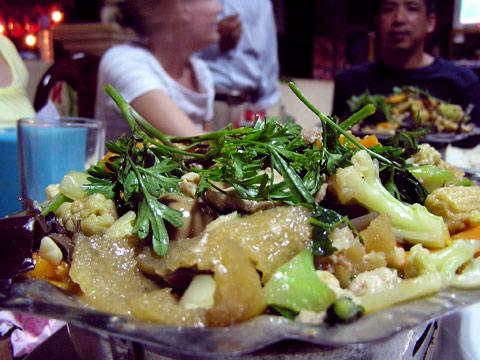
Round 2: Stir-fried mixed vegetables with rehydrated pork skin.
The purpose of rehydrated pork skin is a mystery. After it is removed from the pig, the skin is deep-fried into thin sheets and then rehydrated when the mood takes you. It adds practically no pork flavour to anything and tends to lurk at the bottom of Cambodian soups and stir-frys, surprising diners with the mouthfeel equivalent of stepping on a beached jellyfish. Cauliflower turns up in the strangest parts of Cambodia and this place is no stranger.
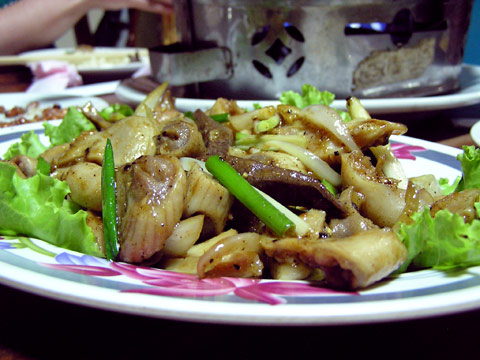
Round 3: Stir-fried pipes with pepper and sugar
Sweet, sweet offal candy! Along with watery sour soup and stirfried morning glory, this dish is one of the staples of Cambodian village travel. I’m not sure what one of the parts in this intestine stir-fry is, but I do know it comes from a pig. The other parts come from a pepper tree, sugar cane and the industrial glutamate factories of Ajinomoto.
The more time I spend travelling South East Asia, the more that I’m convinced that tom yam soup is becoming the South East Asian equivalent of pizza, a food that has become detached from its point of origin to become a regionally-specific genre of its own, for example Malaysian tom yam. This close to the Thai border however, Khmer tom yam is indistinguishable from Thai tom yam nam khon.
Location: Darareah Restaurant, next to the roundabout in Tbaeng Meanchey, Preah Vihear province. If you’re visiting the Preah Vihear ruins from the Cambodian side, you’ll inevitably eat there as dining options in the town are limited.
* – At an event with some coworkers in Sihanoukville, I asked why there were only eight seats per table in this province and ten in other provinces. ‘It’s lucky’ they answered. ‘It’s lucky because in Sihanoukville, we get to eat more food.’
Amokalypse Now: Gratuitous food porn edition
The above photo is the fish amok from Malis restaurant in Phnom Penh : the same amok that I shot for the Wall Street Journal article. I expected that they’d use this photo rather than the one that they did : this is about as well as I can capture gratuitous, selectively-focused food porn without resorting to either Adobe Photoshop or a full-time photographer. The only food styling that I performed was to place a paper napkin under the banana leaf to soak up some of the wayward coconut milk. Otherwise, this is the amok that Malis serves every day.
Location: Malis, Norodom Blvd, just south of the Independence Monument.
See Also: Real Khmer? Cambodian Fine Dining in Phnom Penh, Seeing how the other half lives – Malis and Pacharan
